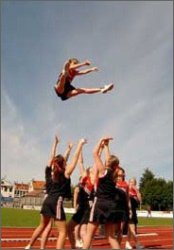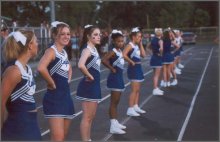Cheerleading: Becoming as Dangerous As These Top 7 Most Dangerous Youth Sports?
by www.SixWise.com
Cheerleading, once a rather tame activity composed mostly
of pompoms and megaphones, has taken an about face in America
over the last few decades.
Today, cheerleaders use gymnastic moves and athletic ability
to flip, somersault and even catapult one another into the
air, with stunts that can rival the excitement of any football
or basketball game.
|

Cheerleading routines have become more complex, more
daring, more exciting ... and more dangerous.
|
In fact, "[Cheerleading has] evolved from a school-spirit
activity into an activity demanding high levels of gymnastics
skill and athleticism," according to a study in the journal
Pediatrics.
It has also become much more dangerous, with the increasingly
complex moves putting cheerleaders at risk of potentially
serious head, neck and other injuries.
Cheerleading Injuries Double Since 1990
The Pediatrics study found that cheerleading injuries have
more than doubled from 1990 through 2002. Participation, however,
grew only 18 percent during that period.
Over the 13-year study, 208,800 5- to 18-year-olds were treated
at U.S. hospitals for cheerleading-related injuries. Almost
40 percent involved leg, ankle and foot injuries.
Researchers say the actual number of injuries is likely much
greater, though, because the study only involved ER-treated
injuries, not those treated at doctors' offices or by team
trainers.
What Makes Cheerleading so Dangerous?
Although cheerleaders use a high level of athletic ability,
cheerleading is still not considered a sport by the majority
of schools.
|

Some schools are choosing to keep cheerleaders "ground-bound"
to reduce safety risks.
|
Because of this, it is not subject to the same safety regulations
as other sports, like football. Meanwhile, cheerleading squads
can exist without coaches or with coaches that have no safety
certifications or training. Some schools also do not have
the proper equipment or space for cheerleaders to practice
safely.
Said Brenda Shields, the study's lead author and an injury
researcher at Columbus Children's Research Institute in Ohio,
"[Cheerleaders may] practice in hallways and practice
on hard surfaces instead of mats. So when they fall off a
pyramid or from in the air and they land on hard surfaces,
the chances for injury are drastically increased."
Some Cheerleaders Get 'Grounded'
In response to safety concerns, some schools are choosing
to prohibit stunts and keep cheerleaders safely on the ground.
The University of Nebraska has prohibited pyramids and other
gymnastic stunts since 2002. The decision to keep cheerleaders
"ground-bound" came after a cheerleader landed on
her head while doing a double back flip at practice in 1996.
She has only limited use of her arms and legs, and the school
settled a related lawsuit for $2.1-million.
The move was controversial, as many cheerleaders seeking
scholarships will avoid schools that don't allow stunts. Other
called it a "sexist" move.
"Cheerleading is considered primarily a female activity,"
said T. Lynn Williamson, adviser to the University of Kentucky
cheer team since 1977. "In our society, it's acceptable
that every year a number of young men will die on a football
field. But, my heavens, if a female breaks a fingernail, or
her arm, well, then it must be time to ground them."
But the spokesperson for Nebraska, Barry Swanson, felt otherwise.
"We didn't eliminate cheerleading or reduce the cheerleading
budget in any way. All we eliminated was the danger ...
In football you have helmets and pads," he said. "Cheerleaders
do their stunts on hardwood floors or turf. We consider that
risk without reason."
Other schools that have "grounded" cheerleading
squads include San Jose State University, which did so in
2004 after an accident, and Duke University, which has forbidden
stunts since the '80s.
How Does Cheerleading Stack Up?
Compared to other youth sports, cheerleading is still one
of the safer options. In 2003, for instance, 100,000 female
basketball players visited emergency rooms for related injuries,
while only 25,000 cheerleaders did so, said Jim Lord, executive
director of the American Association of Cheerleading Coaches
and Advisors.
The seven
most dangerous youth sports in America, based on percentage
of injuries versus total participation, include not cheerleading
but:
-
Football
-
Mountain biking
-
Basketball
-
Soccer
-
Skateboarding
-
Baseball
-
Softball
Nonetheless, the study researchers recommended several approaches
to make cheerleading safer:
-
Coaches getting professional safety training
-
High schools and cheerleading associations adopting uniform
safety procedures
-
Developing a national database for injuries
The American Association of Cheerleading Coaches and Advisors
also has a safety manual for cheerleaders and safety courses
for coaches.
"It's not that the sport is dangerous, but it's people
trying skills they shouldn't," said Lord.
"We are by no means minimizing the injuries; we are
simply putting them into perspective. When compared to other
sports, cheerleading is a low-risk activity," he maintained.
Recommended Reading
The
Seven Most Dangerous Youth Sports in America
"Study
Drugs" -- Use of These Dangerous New Drugs is Skyrocketing
Among the A+ Student Crowd
Sources
Cheerleading
Injuries More Than Double
USA
Today: Schools Limit Risks Routinely
Extreme
Cheerleading: How Schools Grapple With the New Risks